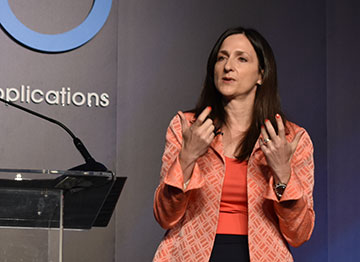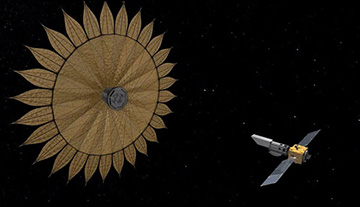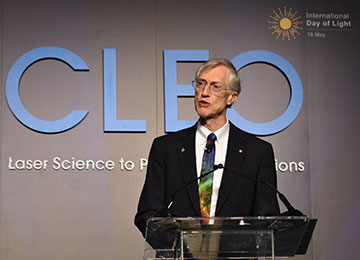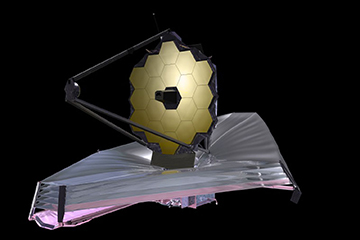Included among the talks at the plenary session of the third day of CLEO 2018 were two that took attendees to the deep reaches of space. Sara Seager of the Massachusetts Institute of Technology, in a presentation titled “Mapping the Nearest Stars for Habitable Worlds,” shared the latest advances in hunting for extrasolar planets, or exoplanets—and how the recently launched Transiting Exoplanet Survey Satellite (TESS) will help find new targets for study. And Nobel laureate and OSA Honorary Member John C. Mather of the NASA-Goddard Space Flight Center, in a special International Day of Light presentation titled “Exploring the Universe at the Speed of Light,” looked at some of the discoveries, in exoplanet science and beyond, that the James Webb Space Telescope (JWST), now scheduled to launch in 2020, could bring.
OPN caught up with both speakers during a meet-and-greet session for a few more words after their talks.
Sara Seager

Sara Seager at the Wednesday plenary session of CLEO 2018.
Sara, I’ve heard it said, based mainly on the results we’ve seen thus far from the Kepler telescope and other sources, that Earth-like planets are likely to be rare in the universe. How much can we say about that?
Sara Seager: Nothing. Kepler found bigger planets at Earth-sun distances, and smaller planets at interior to Earth-sun distance. So you have to extrapolate no matter what you do. And when people do that extrapolation, the answers vary widely—from less than 1 percent to 100 percent. So we really can’t answer that question yet.
Will the Transiting Exoplanet Survey Satellite (TESS)—which you discussed in your talk, and which was launched just last month specifically to look for exoplanet candidates—help to answer it?
Seager: It’s won’t, actually. There are so many different star types, exoplanet types, that each space telescope mission to find planets has its own niche. TESS chose the niche of small planets transiting in front of small stars—what I called, in the talk, “Earth cousins” rather than Earth twins. It doesn’t have the sensitivity to reach down to an Earth-size planet orbiting a sun-size star.
TESS has been described as the “finder scope” of the James Webb Space Telescope (JWST)—specifically, a finder scope for exoplanets. What else will TESS be looking for?
Seager: Exoplanets are the biggest goal, but everyone has their own thing they want to use TESS for. Some people want to do asteroseismology; people are hoping we’ll catch supernovae and other time-variable things. And, of course, there’s the unknown things that we’re hoping to find.
And these are all using the four optical cameras on TESS—which I think in your talk you referred to as “glorified telephoto lenses”?
Seager: That’s right—they go from about 400 to 800 nm, but they’re red-sensitive.

An artist's rendering of the Starshade concept, a project that would, if approved and launched, place a large space-based shade between a space telescope and the target star, to block out starlight and allow light from the orbiting exoplanet to be more easily seen and analyzed. [Image: NASA/JPL-Caltech]
In your presentation, you talked about another fascinating project you’re working on called Starshade. This is a large, flower-shaped structure that would sit at a distance out in front of a space telescope, and block out the light from the star to make it easier to see the light from the orbiting exoplanet and do detailed studies of the planet’s atmosphere. The idea reminded me of another kind of instrument for blocking out starlight, a coronagraph, which is a piece of optics that sits on the telescope itself. Why might you want to have both of these?
Seager: You don’t necessarily need both, but each of them has a useful way to work. If you had a future mission that had both a coronagraph and Starshade, the coronagraph could find planets quite quickly, because the telescope can easily switch to another star. Starshade is very slow, because it has to move around to retarget each time it moves to another target star. But Starshade is more capable than a coronagraph, because the coronagraph can work only in very narrow bands, where Starshade can be very broadband. The coronagraph can also be low throughput, because it has to have many, many optical elements, and each of those decreases the throughput.
So you can imagine a very efficient mission where you find planets with the coronagraph in a 100-nm-wide band, and then when it finds interesting things, Starshade can take its time to move across the sky and line up to do a deep spectrum. So that’s why we’d like to see both. I wouldn’t say it’s necessary, but they’re very complementary.
John C. Mather

John Mather gave a special International Day of Light talk at the Wednesday plenary session of CLEO 2018.
John, how do you view the TESS and JWST projects working together?
Mather: TESS will definitely say “look right here right now; something’s going to happen.” What we can do that will help to follow that up is atmospheric transmissions during the transits. We can do atmospheric spectroscopy on those targets, to see what’s in the atmospheres of those things—if there is an atmosphere. We’re looking for haze, for clouds, for changes with time. We’re looking for all the molecular features that would tell you the chemistry and temperature.
As you laid out in your talk, the JWST is about a lot more than exoplanets—there are a number of other broad science goals, including looking at the formation of the earliest stars and galaxies, and other phenomena dating back to nearly the Big Bang. Which of the telescope’s science goals is the one you’re most excited about?
Mather: I would say that there’s one we didn’t say anything about—which is the likelihood of surprises. We’ve said what we were going to look at, but we don’t know what we’re going to see. I’m kind of hoping there’s a category of object that nobody has dreamed up yet that will turn up in our pictures.
In the talk, I mentioned that the Webb Telescope would be able to see a bumblebee at the distance of the moon—that says that if there’s anything out there that we haven’t thought of, there’s a chance to find it. One category would be primordial objects—the first generation of things after the Big Bang, but before galaxies grew. Another thing is that everything we know about planets has been a surprise—theorists have not predicted one single thing before we looked at it. That’s another good place for surprises. So we’ll try and see what happens—see what nature gives us.
In your talk you discussed the JWST, but you also touched on the big, next-generation ground-based telescopes currently being built—the 25-m Giant Magellan Telescope, for example, and the 40-m European Extremely Large Telescope. What can these ground-based telescopes do to complement something like JWST?
Mather: Well, I guess the number-one thing is that they’re a heck of a lot bigger. If you’re looking for more photons, these telescopes are the thing to have. They can do high-resolution spectroscopy, which we don’t have on the Webb Telescope. They can do much better spatial resolution than we can do, because diffraction matters. Anything you can see from the ground with the optical band, that’s definitely the thing to have. If we can do something from the ground, we’re not doing it in space—it’s too hard.

An artist's rendering of the James Webb Space Telescope fully deployed, with mirrors unfolded (gold hexagons on top) and plastic sunshade (bottom half) fully unfurled. [Image: NASA]
The JWST is a huge project with amazing engineering, spanning multiple years. But there are so many things that can go wrong in a space mission. With so much at stake in a good outcome for the Webb Telescope, how do you sleep at night?
Mather: This is actually normal business for all NASA missions. In our business, we just say that we’ll do what we have to do to make sure it’s as reliable as it can be. And that includes many steps.
So if there’s anybody who wakes up in the middle of the night and says, I’ve got a problem, we say, OK, tell us about it; we’ll write it down and we’ll make a plan to deal with it. And we’ll test it, and test it a lot. And we have review boards, who come and tell us whether we’re doing the right thing, because we really want to know now if we’re missing something. On the telescope itself, we have two of everything that we can—two ways to turn on every actuator, for example.
So that’s sort of how we do it—it’s standard; it’s the process we go through. And it usually works. We’ve had a pretty darn good batting average over time, but this one is harder. The sunshade is particularly hard, and really different—we’ve had plenty of hinges in space before, but we’ve never had a big piece of plastic to unfold like that.
